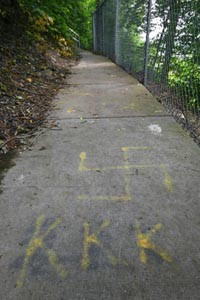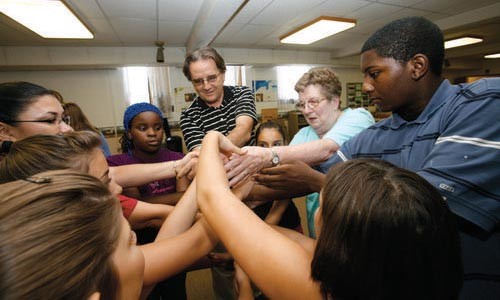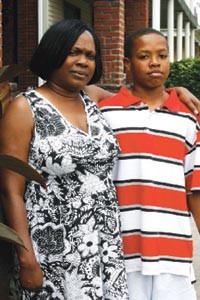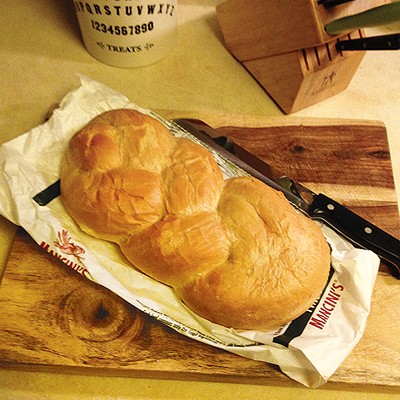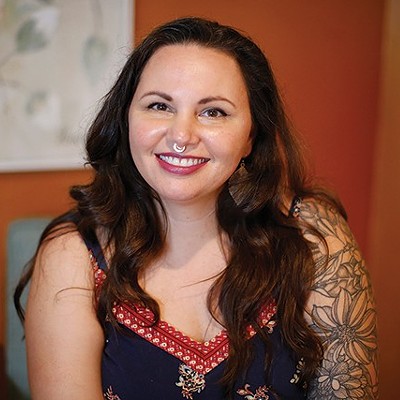To a visitor passing through, the borough of Verona almost looks like something out of a Norman Rockwell print. A slightly faded print, perhaps, as if it had been taped to the inside of one of the empty storefronts along Allegheny River Boulevard ... but a Rockwell print just the same.
On a recent summer day, residents tended gardens or took shelter in the shade of their porch, greeting neighbors walking by. Over on South Avenue, a few blocks up the hill from the boulevard, three borough firefighters hopped out of a red "Rescue Squad" van, looking for a runaway dog. Over on Herron Avenue, a child pedaled his tricycle along the sidewalk, his mother by his side.
Lining Allegheny River Boulevard itself are purple signs that boast "Verona, Proud of Our Heritage." At the intersection with Center Avenue, a mural repeats the slogan above a depiction of a large train -- a reminder of Verona's origins as a railroad suburb.
But just a block down the boulevard, at its intersection with Union Street, there's evidence that Verona is prouder of some kinds of heritage than others.
Crudely painted on the side of an insurance building are the words "Fuck Niggers."
"That right there is as plain as it gets about the racism in Verona," says Troy Jones, 34, who has lived in Verona for more than two decades. The slur has been painted there for the past few years, he says: "You would think the borough would come and do something about it."
But a lot has been changing in Verona in recent years. White and black residents agree the community's African-American population is growing. Older residents, meanwhile, are dying or moving away, and family homes are being converted to rental properties. Increasingly, black residents are alleging racial bias by police, and even a church youth program has become a lightning rod for criticism.
If some of his neighbors have stereotypes of black men, Jones acknowledges, "I fit the part." An aspiring rapper with gold teeth and a gold chain around his neck, he's also been convicted of criminal offenses, including minor drug and assault charges. But he says that his family moved to Verona 20 years ago -- and that he's stayed here ever since -- for the same reason many other families do.
"Verona was a place that you could raise a family," Jones says. "It wasn't city life, where you have to worry about being robbed walking down the street."
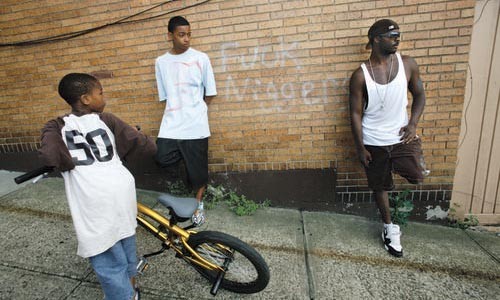
"If you can't keep up with the times, then who do you blame for that? The world's not going to stop growing because you're stuck in a time zone."
Verona's 3,000 residents live on a half-square-mile plot sandwiched between Penn Hills and Oakmont. Running alongside the Allegheny River and the Allegheny Valley Railroad, which was built in the 1850s, Verona is easy to overlook. For many, it's the place you go through to get to the much larger Penn Hills -- whose population is roughly 47,000 -- or to the wealthier Oakmont. (Median annual household incomes in Oakmont are roughly $10,000 higher than in Verona.)
To Paradise Gray, a black Pittsburgher who ran a church youth group in Verona for more than three years, part of Verona's hostility to new arrivals stems from a lingering inferiority complex.
"They always felt that they were second-class citizens to Oakmont," Gray says. "With the black kids, their image is ruined."
But the fact that black residents are attracted to Verona is a compliment to the community, say the newcomers. Part of the appeal is the Riverview School District, which Oakmont and Verona share and which Jones says is "excellent." Inexpensive but decent housing is another draw: Celeste Jones (no relation to Troy) moved to Verona in May after being born and raised in Penn Hills. The reason: a spacious two-bedroom apartment for just over $500 a month. "You can't get a place like this in Penn Hills," she says.
According to the most recent U.S. Census, blacks made up just 3 percent of Verona's population in 2000. But anecdotal evidence suggests the black population has been growing rapidly since then.
When Troy Jones first moved to Verona as a teen-ager, he was one of only a handful of blacks. But in recent years, he says, "I've noticed a lot more black families."
Jones' neighbor, Lori Berry, agrees. When she first moved from Penn Hills with her daughter and three sons three-and-a-half years ago, "We knew who the black people were," she says. "Now I'm looking at the black people in the street like, 'Who the hell is that?'"
White residents are asking similar questions -- though they were wary of being quoted in a newspaper story while doing so.
"I'm not as comfortable as I used to be," says one Verona resident of 47 years, sitting on her porch just a few blocks away from Berry's home. "[I'm] a lot more frightened. ...We have a lot of single mothers -- a lot of black babies [are] being born.
"The kids are always hollering and whoopey-doing," she adds. "They don't seem to have respect at all."
"The neighborhood has definitely changed," says the woman's daughter, who also requested anonymity. And while she says there is no overt racial conflict, "There is some tension" between blacks and whites.
"How would you describe the change, other than bad?" the daughter rhetorically asks. "I don't like it."
They aren't alone. Herron Avenue, where Troy Jones and Lori Berry live, is frequently referred to as "Heroin Avenue." According to statistics on file with the Pennsylvania State Police, there were seven drug offenses in Verona during the first six months of 2008, a rate essentially unchanged from the same period in 2006 (the earliest year for which the state has such data on file.) That's a miniscule number when compared to the more than 1,300 drug offenses recorded in the city of Pittsburgh during the first six months of this year. And in recent years, crime rates have held steady: The total number of offenses in Verona, both minor and major, is actually down slightly from 2006. But in a town Verona's size, even a small amount of crime makes a big impression: State data shows that per capita, crime rates in Verona are slightly higher than in Pittsburgh, though the vast majority of offenses committed in Verona are relatively minor infractions like vandalism, disorderly conduct and theft.
Berry says that, to some extent, she can "truly understand" the concerns of long-time residents. "A lot of people have been born and raised in this town. ... A lot of people are not accepting [of] change."
Berry admits the change wasn't easy for her, either: A Penn Hills native, she "never ... felt uncomfortable because of my race" when growing up, she says. Blacks make up one-quarter of Penn Hills' population, and Berry says, "When I got here, just on the other side of Penn Hills, I figured, 'What could be so different?' I was just shocked. ... Sometimes in this town they go too far."
Like, for example, the time Verona police officers barged into her home without a search warrant.
On Jan. 17, Berry says, a Verona police and county probation officer searching for a 17-year-old suspect entered her home without her permission. Though the officers had no search warrant, Berry says they searched her home for nearly half an hour before leaving -- without finding the suspect. The police officer said, "We don't need a search warrant," recalls Berry. "I said, 'You're violating my rights,'" but she was ignored.
According to the police report compiled on the incident, officers had an arrest warrant for the suspect, and entered Berry's unlocked back door when their knocking at the front door went unanswered. "We stepped into the kitchen area and announced who we were and that is when Mrs. Berry came into the kitchen area," the report reads. "We ... informed her that we have good information that [the suspect] was inside her residence."
"It doesn't sound good," says Bruce Ledewitz, a professor of law at Duquesne University. Ledewitz says it's hard to judge the officers' conduct just on the basis of a police report, and he says officers might have had the right if they had "credible evidence" the suspect was inside: "If there is a chase, and they see someone go in [the house], they can be there without a search warrant." But the report makes no mention of such evidence; it says only that police had "good information [the suspect] was inside." Berry, who is planning to file a lawsuit related to the search, says officers told her they'd seen the suspect with her son previously. But Ledewitz says that unless police have a more immediate justification, Berry has "a credible claim."
Nor is this Berry's only complaint with police. Like other black residents -- and some whites -- she believes black children are more likely to be cited than whites for violating Verona's curfew.
Berry says that at one time she "literally had stacks of citations" -- each of which costs $25 -- for violating curfew, which in Verona requires kids under 18 to be home by 10 p.m. Her daughter, Alexis, says she's been cited roughly a dozen times during the three-and-a-half years she's lived in Verona. Her son, Allen, says the police "follow us" whenever he and his friends are out. He says he once heard an officer tell his friends, "If you're out past curfew, we'll Tase you."
By contrast, "My kids have never gotten a citation," says Melanie May, who is white and Jones' girlfriend. Her daughters, who are now 15 and 18, have lived in Verona most of their lives, and May admits they've frequently been out after curfew. The violations are "motivated racially," she believes.
Four phone calls to Verona's mayor, Leonard Brennan, were not returned. (In a community newsletter published earlier this summer, Brennan wrote that he was taking an "extended vacation" in the American southwest.) Calls to Verona Police Chief Guy Truby's office went unreturned. When a CP reporter visited his office, Truby refused to answer questions.
"No comment, sir," he said, standing in the doorway to the department headquarters. "Have a nice day, sir," he added before closing the door.
Verona police may not be the only ones paying special attention to black residents. Take, for instance, a widely circulated June 2006 e-mail sent from the Verona Community Action Group (VCAG).
VCAG organizes community events like neighborhood clean-ups and block watches, keeping members informed about potential community concerns. In the summer of 2006, VCAG founder LeaAnn Grill sent an e-mail advisory noting, "There have ... been reports of several individuals from the Homewood area who are trying to rent or purchase property in Verona.
"If you should notice either a green Suburban with spinners on the tires, or a black Jeep Cherokee at a residence for an extended amount of time (8 hours or more) or see anyone fitting the description moving into a property, please call the police department with the address."
"That proves how they do that racial profiling here," says Berry. "It's just ridiculous."
"I don't even remember that," says Grill, a Verona resident of 18 years, when asked about the e-mail. The information specifying Homewood, and specific car models, "came from the police. What the police wanted to know is, 'Are these people, in fact, truly interested in renting properties?' ... If that's truly what they're saying when they pull up, is that just a façade for why they are truly there?"
Even so, Grill says, far from feeling threatened, Verona welcomes the changes coming to it. "Verona is definitely improving," she says. With its "quaintness" and walkable streets, "We could be another little Shadyside."
When Paradise Gray first came to Verona four years ago, he didn't have to look any farther than the local basketball court to see evidence of a racial divide.
Gray is a community activist with a long history of working with young people; in Pittsburgh, he's perhaps best known as the organizer of One Hood, an anti-violence initiative targeting at-risk city youth. So when Rev. Don Dilley, the pastor of Verona United Presbyterian Church, inaugurated a youth program called "Almost Home" in December 2004, Gray seemed a natural choice.
Almost Home is a twice-weekly after-school program in which kids come for dinner, play video games and use computers in the church basement. They also make use of the basketball court and other facilities at Cribbs Field, a community park just across South Avenue from the church.
But shortly after he began working at the program, Gray noticed that instead of playing full-court basketball, kids played two separate half-court games: one for whites, the other for blacks. When the kids later took to the football field for a game, one of the kids shouted "Let's play black kids against white kids!"
"There ain't white kids and black kids here," Gray interjected. "There are only kids here." But once he started choosing -- and integrating -- the teams, the kids "started forming relationships with each other."
But while Almost Home has helped bridge some racial divides, says its sponsor, it has reflected others.
"[Neighbors] wanted us to stop the program," says Dilley. "[They said] it was affecting the Verona community."
"Do you want the truth?" asks Jean Wynn, 74, a church deacon and program supervisor. "It's racial."
Not so, say borough councilors who've criticized the program.
"I'm not a supporter of the program because of the way it's running," says Councilor Earl Hendricks. "It's not a racial issue. The founders of the program have made it a race issue."
Council member Peggy Suchevich offers another complaint: The kids participating in Almost Home, she says, don't have homes in Verona.
"I've seen those children getting out of a van," she says. "I don't know where they're bringing them from, but they are not from Verona."
Dilley says this is a widespread but false belief, promoted by members of VCAG who are hostile to the program. The program is roughly a 50/50 mix of blacks and whites, he says, making it much more racially mixed than the community as a whole. As a result, he says, some residents have "this vision of buses coming and unloading these black kids," he says. "The kids had to be from outside [Verona]."
Dilley says he showed a list of the kids' names and addresses to a VCAG member, but the response was: "Did you call each one of those kids to verify that they were from Verona? ... How do you know they weren't lying?"
Dilley acknowledges there have been problems with oversight. Once word of the program spread, it began attracting as many as 80 kids, some of whom merely popped into the church to grab food before running across the street to the playground. "We hadn't anticipated that volume," says Dilley. "And there was chaos between the church and the playground across the street," he says. Finally, a fight broke out on the playground in June 2004, just after that day's program ended at 7 p.m.
In that incident, four girls -- two of whom were black, and three of whom were involved in Almost Home -- beat up a young white girl across the street from the church. The girl was injured badly enough that she had to be taken to the hospital.
Dilley says he doesn't know what the fight was about, and notes that the incident took place off church property. Still, he acknowledged that the program wasn't perfect. He began making sure kids signed in, so they weren't simply grabbing food and then leaving for the park. That change, he says, shrunk the program significantly -- attendance now numbers around 30 -- and made it easier for supervisors to monitor the kids. (These days, Dilley says, the program usually has one adult supervisor for every four or five kids.)
But four years after the June 2004 fight, criticism of the program continues.
Gray himself is a target. With his dreadlocks, connections to local leaders in the Nation of Islam, and a MySpace page that features a post-Katrina photograph of Gray extending the middle finger while standing beneath a FEMA sign, it's no surprise his presence in a church program raised eyebrows. Dilley says some residents protested Gray's involvement; Gray left this spring, believing his presence was becoming a distraction.
"We were under this constant attack," Gray says.
For their part, the kids in Almost Home say criticism of the program goes too far. Sometimes kids act up and get loud, they acknowledge, but not having the program would be far worse. "People like the fact that there's a building where kids can hang out," says Chaze Monroe, a black 18-year-old who has participated in the program for the past two years.
The church program "keeps kids out of trouble," agrees Drew Obenreder, a white 17-year-old who has been active in the program. Given the lack of things to do in Verona, he says, "There would probably be a lot of problems if the program wasn't there."
If anything, kids in Almost Home say their biggest problem is being hassled by police. Obenreder, for example, says Verona police have gotten "real racial" in recent years. On one occasion, he says, he watched an officer confront some black friends; the officer, Obenreder says, called his friends "black [and] illegitimate" and told them to go home.
Dilley has actually urged the kids in his program to write up accounts of their run-ins with police. That way, they would have a documented history of alleged harassment.
"I went into the newsstand to get a drink and so did Mike," one letter reads. "Mike went out before me and I guess the police thr[ew] him on the ground. When I came out I tried to grab Mike's hat ... and wallet ... and the police officer smacked the stuff out of my hand and started swearing at me and told me to leave or I was the next to get arrested."
Grill and others say that, whether the subject is policing or community objections to the Almost Home program, it's unfair to speculate about racism. Grill says VCAG's main concern with the program was that there wasn't enough adult oversight. While it has been better supervised lately, she says, "Without supervision, children are going to find trouble. It's that simple.
"I don't like to see a situation turned into a racial one if none exists," Grill says. "I don't like to see that twist."
Borough Councilor Suchevich takes particular umbrage to criticism of the police department.
"I will vehemently deny that the police are doing anything wrong," she says. "They are doing their job.
"Verona is not racist," she adds. "That is just ludicrous."
In fact, says Dr. Larry Davis, it would be too easy to chalk up such conflicts to outright racism.
For one thing, Verona is not an isolated case, says Davis, dean of the School of Social Work at the University of Pittsburgh. "This has been a legacy in America," he says. Whenever a community's racial demographics change, "We've always had pushback." And the motive is not so much racial as economic.
A certain percentage of racists can be found in any community, Davis says, but most people don't object to newcomers "solely because they're black. ... What they are saying is that, 'Well, the black people will come and lower my property value.' Whites perceive it as a threat to their way of life."
In other words, white resentment is not motivated solely, or even mostly, by fear of other people's race. It's also motivated by fear of other people's racism -- the belief that other whites will move out, undermining the value of homes nearby. "We've been inclined to attribute all of this [racial strife] to just ignorance," Davis says. If it was just ignorance, "we'd have solved America's problem a long time ago. ... [Race] is not as simple as people think."
And Verona's racial mix isn't all that is changing. Anecdotal evidence suggests that many homes are being converted into rental properties -- and an increasing number of rental properties are being occupied by low-income families. In recent years, there has been a sharp rise in the number of Verona apartments that qualify for Section 8 vouchers -- financial assistance given to low-income families as an alternative to "warehousing" them in housing projects.
Section 8 has been an increasingly controversial program. A July article in The Atlantic magazine, for example, reported that in some cities, crime has followed Section 8 recipients as they followed vouchers out of city neighborhoods and into inner-ring suburbs -- in part because those communities didn't have police forces or social-service agencies equipped to deal with the new arrivals.
According to the Allegheny County Housing Authority, since 2006 the number of Section 8 vouchers issued within Verona has grown from 48 to 60, a 25 percent increase.
"If Section 8 moves in, it lowers property values," Davis says. "It's poverty, is what it is." And for the people living next door, it's not always easy to distinguish issues of race from issues of class. While Section 8 vouchers are extended to black and white households alike, "Welfare is stereotyped as being black."
So far, there's little sign that housing values in Verona have been hurt. According to RealSTATs, a Pittsburgh-based firm that tracks property sales, in 2007 some 28 Verona homes were sold for a median price of $59,750. That's almost identical to the $59,700 median price for the 40 homes sold back in 2003.
But fears about unraveling property values and fraying communities can be self-fulfilling. Studies suggest that when a community's black population reaches 20 percent, a "white flight pattern" can set in. Perhaps not surprisingly, Davis says studies also show that whites are most comfortable in groups where blacks make up 20 percent or less of the population. Blacks have a much higher tolerance for racial diversity, expressing contentment with a 50/50 racial balance.
Whites are so accustomed to being in the majority, Davis says, that "even when [blacks] are in numbers like 40 [percent], I argue that [whites] are psychologically outnumbered."
And while Davis doesn't excuse bias in policing, he says police behavior too needs to be considered in a broader context. "They're there to protect and serve," Davis says. And in a majority-white community, this means they "protect and serve white people. ... They're just doing what the community wants to be done."
And local authorities may simply not be equipped to do anything else. Of the borough's seven councilors, none are black. There are also no black officers on Verona's police force, which consists of three full-time and seven part-time officers.
What's the solution?
It would help to have at least some black representation in government, Berry says. But ultimately, she says, "There needs to be communication. People need to talk more."
Could it be that simple? Fourteen-year-old Allen Berry sees evidence every time he attends the Almost Home program. "It gives a good name for this church," he says.
Wynn, the church deacon, says the program has prompted some racial outreach among adults as well. One elderly parishioner, Wynn recalls, was shocked by Gray's long dreadlocks and funky clothing. So she told Gray, "Go out there and be so sweet to that lady. She's afraid of you."
According to Wynn, Gray took the woman's hand and politely introduced himself. And afterwards, "I went up to her and said, 'See? Isn't he nice?' And she said, 'He's a lovely man.'"
Dilley says such acceptance may be taking root amongst the rest of the congregation as well. One church elder, he says, said that accepting Verona's newest residents became easier once "We just sort of saw them as our neighbors."
But not everyone may feel the same way.
Whether it's because of animosity to the program, concern that they might be included in a lawsuit against it, or some other cause entirely, Dilley can't be sure. But something has happened to his church's predominantly white congregation: Where Sunday morning services once saw 60 worshippers, today there are less than 30.

